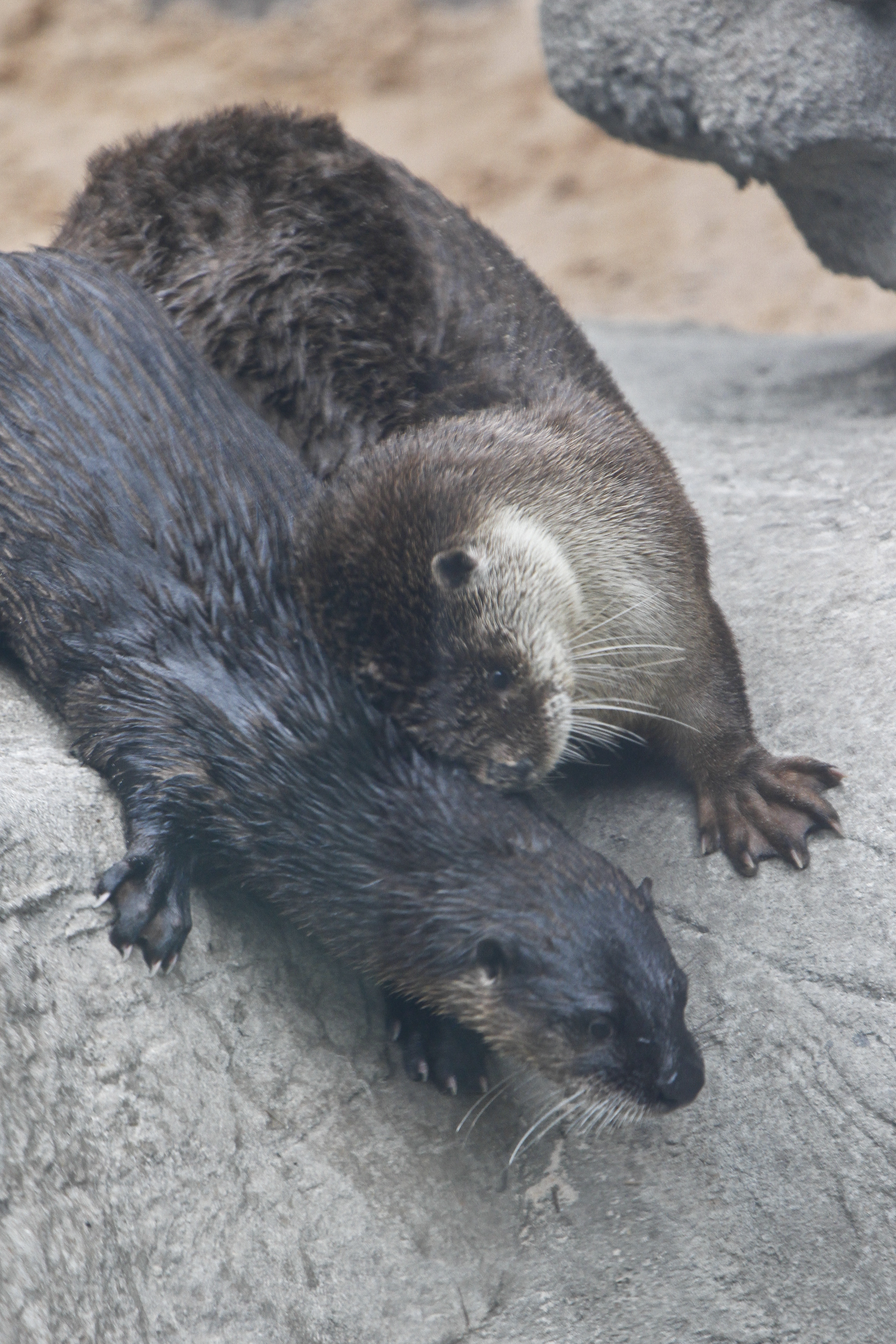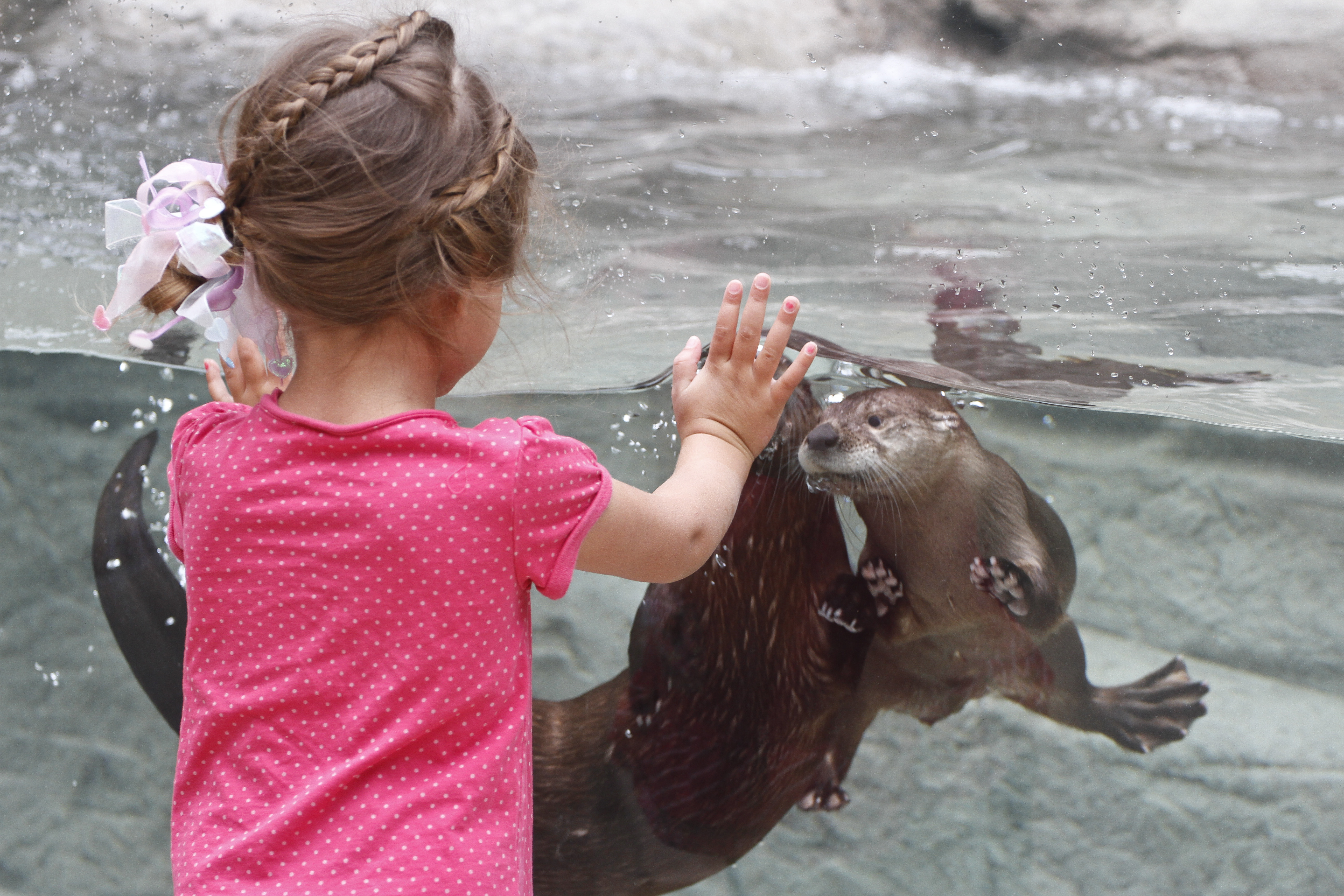New and oldHere's a side by side comparison previous exhibit vs. today:NEW SPACE / OLD SPACE* Exhibit space: 1465 square feet / 481 square feet* Exhibit space for guests: 420 square feet / 180 square feet* Acrylic viewing space: 32 linear feet / 13 linear feet* Backup space for otter care: 406 square feet / 100 square feetABOUT RIVER OTTERS• North American River otters are one of 13 species of otters that occur in the world.• They are members of the weasel family. Their natural diet consists of fish, crayfish, frogs, salamanders, snails, snakes and insects. They typically feed from dusk to dawn.• They use their whiskers to detect prey in murky water. Otter's have excellent eyesight underwater and a keen sense of sense. All four feet are webbed. They have ear and nose flaps that close to protect their eyes and ears while under water.• Otters have two types of fur: downy fur close to their skin traps air to keep them warm while the outer layer of guard hair is oily and help to repel water.• During a dive, their pulse slows to a tenth of the normal rate of 170 beats a minute, thereby conserving oxygen.• River otters dive to depths of at least 60 feet and can stay submerged for more than 4 minutes. They can run as fast as a man and on hard snow or ice reach speeds of more than 15 miles per hour by alternately running and sliding.Source: Tennessee Aquarium
Downtown Chattanooga living just got roomier and more luxurious - for river otters.
The Tennessee Aquarium spent $1.7 million to rebuild its "River Otter Falls" exhibit, the most extensive renovation in the aquarium's 22-year history. The exhibit officially opens Friday.
It's bigger - three times the size of the old one. There's room for seven otters, now, instead of two.
It's better for the playful mammals, aquarium officials say. Otters are primarily land animals that like to swim. So the new exhibit has lots of shoreline - complete with digging pits for otters to roll around in to keep their fur clean - next to a fast-flowing stream with waterfalls.
And it's easier, now, for visitors to watch otters swim and frolic underwater because the new exhibit has a lot more glass to look through.
"Pretty cool," 9-year-old Presley Coker summed things up as he and his family visited from Pontotoc County, Miss.
Aquarium officials have wanted to upgrade the otter exhibit since 2007, said Jackson Andrews, the aquarium's director of operations and husbandry. The aquarium held off on otter improvements while it worked on penguin and jellyfish exhibits. Officials decided to give otters a go after a marketing study predicted the marine mammals would be a hit.
"It just showed that it would be very popular with our visitors," Andrews said.
Construction began the day after Labor Day on the new exhibit on the top floor of the aquarium's River Journey building. It's underneath one of the four iconic glass peaks on the building's roof in the Cove Forest, a simulated creek and woods high in the Appalachian mountains.
Workers hauled off about 300 tons of debris from the old otter exhibit one wheelbarrow at a time in a freight elevator, Andrews said. He praised the work done by Counts Co., a local general contractor, and local subcontractors Jake Marshall Mechanical, Lawson Electric and Yerby Construction, along with Cemrock and Hammerhead International.
"If you look at the rock work in this exhibit and you look at the old rock work - it's seamless," Andrews said.
The seven otters come from three sources: an orphaned brother and sister were rescued in South Carolina; one otter, Delmar, has lived for nine years at the aquarium's old exhibit; and four males were caught in Louisiana. The Tennessee Aquarium named its otters Maya, Bennie, Louie, Scout, Hunter and Digger after getting suggested names from 600 people on Facebook.
"What's great about the wild-caught males is they were actually caught in crawfish fields," otter caretaker Courtney Lewis said. "If we had not gotten them, they would have been sold for fur."
Maya is the only female. In the wild, it's common for groups of bachelor males to live together, and aquarium officials initially planned to have only male otters. That changed, though, when Maya and her brother became available.
"That pair - it's probably their youthful exuberance - has really sort of sparked up the behavior of these adult males," aquarium curator of forests Dave Collins said. "It's like kids jumping in bed with mom and dad."
Backstage, the new exhibit has six separate otter cages, including one that's equipped with a built-in pool and is big enough for a female otter to hide out with her young.
"They don't want anything to do with other otters," Collins said. "She just wants to tend her youngsters."
One day, the aquarium would like Maya to have otter pups. Zoos and aquariums around the country treat otters as one population under a species survival plan.
"We'd like to contribute to that by breeding otters," Collins said. "That may be a while down the road."
The otters are fed small fish and "meatballs" that are a mix of raw horse meat and vegetables. Horse meat is a common animal feed in aquariums and zoos, because it's similar to wild game.
The Louisiana otters aren't the first of their kind to relocate here.
When the Tennessee Wildlife Resources Agency started releasing river otters in the early 1980s to boost their numbers in the wild, the agency got otters from a Louisiana Cajun trapper named Leroy Sevin, said Bruce Anderson, a retired TWRA biologist who helped restore otters to the wild here.
"We got virtually all the otters from him," Anderson said last week during a visit to the River Otter Falls exhibit.
Tennessee's otter restoration effort was a success.
"They did so well by 1999 we were able to take them off the endangered species list," Anderson said. "They're in every river system in the state, now."
In the wild - unlike at the aquarium - otters are cagey and hard to spot.
"I never saw more than one or two in the field," Anderson said.
Contact staff writer Tim Omarzu at tomarzu@timesfreepress.com or 423-757-6651.


